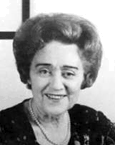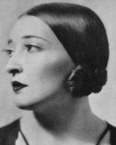Posted January, 2009 by Bob Sherman
Much has happened since the Nadia-Clara website went on line last November, so this is first of what may turn out to be periodic updates.
• First of all, we’ve added some names, e-mail addresses and comments to the list of Nadia’s students, and corrected a few misspellings along the way. We also provided a link to the remarkable Reisenberg video, prepared by, and stored at the University of Maryland Piano Archives. If you haven’t seen it, by all means, take a look.
• It’s never too late to learn. We’ve always listed 1922 as the year the Reisenbergs arrived in New York, because that was Nadia’s memory. Turns out she was wrong. According to Barry Moreno, of the Ellis Island Immigration Museum, the family arrived in New York Harbor on 19 December, 1921, and were questioned in the Great Hall on the 20th. Now if only I can figure out how to change everything in Groves and all the other encyclopedias…
• The fourth winner of the Nadia Reisenberg Memorial Award at the Mannes College of Music, the English pianist Sam Armstrong, plays his debut recital at Weill Hall January 26th.
• A new series of free NR Memorial Concerts, presenting laureates of the New York Piano Competition, will be held at the Ossining (NY) Public Library. The dates are February 22, March 29, and April 26.
• Yishai Rubin, an 18-year old Israeli pianist, has won the 2007-2008 NR Scholarship Award, administered by the America-Israel Cultural Foundation.
• With the permission of the Foundation, two of Clara’s recordings (with Nadia) were used in Don Bernier’s fascinating documentary film, “Shelf Life,” about the skull collection of retired Bay Area science teacher, Ray Bandar.
• A long article/review by Anthony Tommasini on the front page of the Arts section of The New York Times (1/5/09) was headlined “Reopening a Pianist’s Treasure of Chopin.” Among other glowing comments within it:
“Reisenberg’s playing is exceptionally beautiful, distinguished by warm tone, impressive clarity, unostentatious virtuosity and unerring musical insight.”
“There is an affecting directness to her playing…an utterly natural lilt and flow.”
“The performances of the Nocturnes are particularly fine, played with pearly sound, melting lyricism and textural clarity.”
“This (the Chopin B Minor Sonata, from a live recital) captures Reisenberg at her most impetuous. This is a blazing, exhilarating performance…”
“Perhaps this ‘Chopin Treasury,’ which truly is a treasure, will build demand for Reisenberg’s self-effacing and distinguished artistry.”
• From a review posted on the internet by David Greenburger:
Robert Moog, who was enamored with the theremin as a teen and went on to invent an electronic instrument which bore his own name, coaxed Rockmore out of retirement in 1975 to record a couple of hours of her repertoire. Half of them were then released (and later reissued on CD), but the remaining performances remained on the shelf, Rockmore herself referring to them as her “lost album.” While she didn’t live to see this release (she died in 1998 at age 87), it has been lovingly assembled by her nephew. Two selections have been judiciously embellished with a cello section, and another with classical guitar. With accompaniments by pianist Nadia Reisenberg, the general familiarity of much of the material (Schubert, Chopin, Ravel, Gershwin, Bach, etc.) allows the focus to land squarely on Clara Rockmore’s mastery of the theremin.
• From a review posted on the internet by “Uncle” Dave Lewis:
Leave it to producer Robert Sherman, director of the Nadia Reisenberg-Clara Rockmore Foundation, and son of Reisenberg, to get the missing 13 Rockmore/Reisenberg selections out, finally, on Bridge Records’ Lost Theremin Album. The quality of Bridge’s digital transfers of the 1975 studio tapes is outstanding: they have a nice top, are not his sy, and establish a pleasing sense of presence for Reisenberg’s piano. In the case of the three tracks already circulated on an IPAM issue, Sherman has decided to replace Reisenberg’s track with newly recorded chamber groups and guitarist Jorge Morel to good effect — these cuts help refresh the overall texture of the album precisely where it might have bogged down. Rockmore’s playing of the theremin, of course, is masterly — girlish, like something between a violin and a human voice. Moreover, there was its tremendous significance: at a time when cynicism, and not a small amount of fear, was the average musician’s take on the whole idea of electronic music, Rockmore proved that electronic technology could produce a result that was both musical and responsively human. As a representation of her gifts and overall contribution to music, Clara Rockmore’s Lost Theremin Album makes the transition from being “lost” to leading the pack — it is the best CD on Rockmore out there. Anyone interested in electronic music should own one.
• From a review in the (London) Telegraph by Geoffrey Norris:
This is perhaps one for theremin aficionados, but there is also something more generally appealing about a disc that captures this arcane instrument’s unearthly sound with such musical finesse. Accompanied for the most part by her pianist sister, Nadia Reisenberg, Rockmore gives a programme of 16 miniatures, ranging from Bach to Gershwin, Chopin to Ravel, Schubert to Dvorak, with some less familiar names as well. Her manipulation of the air- waves has an eerie vocal quality, especially (but not exclusively) in the aria from Villa-Lobos’ famous Bachianas Brasilieras #5. Lyricism is what the theremin does best, and Rockmore’s contriol of pitch, dynamic shading and phrasing are a marvel, considering the risk of approximation that the instrument harbours.
• • •
REACTIONS TO THE WEBSITE:
• From David McGill, Principal Bassoon, Chicago Symphony Orchestra:
“I just wanted to let you know how marvelous your website is. I’m sure both your mother and aunt would both be proud of this achievement. I was shocked and inspired to hear the opening of the second movement of the Franck Sonata played by them together when I logged on to the home page! I have dreamed of hearing this live recording. What a treasure it is. I sincerely hope the resources will be found so that this “unknown” recording might someday be released along with other lost gems. As ever, I am grateful to you for your dedication to your amazing relatives. They have both enriched the world and they continue to do so through your efforts.”
• From Wayne McEvilly:
“Among the most precious hours of my life were those with Nadia Reisenberg. I would love to share my memories with other former students.
mcevillymozart@gmail.com (405 493-0957)
• From Thomas Grillo (Jackson, MS):
“Hello. I just wanted to thank you so very much for making this foundation, and site available to the public. I have been enjoying learning, and playing the theremin for the last few years, and shall continue to do so. I was inspired by Clara’s theremi n playing, and I will certainly have my theremin students visit this site. Thank you, and keep up the great work!”
• From Barney Sherman (no relation):
“I did take the liberty of posting a Wikipedia article on your mother. My view is that most younger people today go to Wikipedia for any information on anything, and she certainly deserves their attention. I am loving the (Nadia Reisenberg) Chopin CDs — very moving — and will acquire the Haydn next. It is indeed wonderful that (Bridge Records) has brought the Chopin back into circulation!”
• • •
Needless to say, I welcome any other thoughts, reactions and suggestions. I’m also deeply grateful for the generous donations to the Foundation from former NR students Jinho Kim and Gwan-Ying Wu, which will help make possible future recording projects.
Among the many items on my wish list: the rest of the 1947 Carnegie Hall recital, the Brahms Viola Sonatas with Paul Doktor, the Library of Congress performances of Mendelssohn and Brahms with the Juilliard String Quartet, Clara and Nadia’s live performances (some with the violinist Erick Friedman) on my WQXR “Listening Room” program, and maybe — some day — the complete Franck Sonata that they recorded at home, and a snippet of which — lousy sound and all — greets you as you enter the site.
Meanwhile, thanks for sharing, and helping preserve the legacies of these two great musicians.


